HD 68988
AXA Light Curves
Links internal to this web page:
Comments
Basic
data
2009.03.29 OOT Observations
OOT LCs
False alarm transits
of 2009 February & March
Finder
images
References
Comments
So far this exoplanet system has not proven to exhibit transits,
even after attempts for many years.
The following is my 2009.03.29 e-mail in which I declared the AXA position
that the possibility for transits of HD 68988 are "dead."
|
Exoplanet Observers,
This is an update on HD 68988, which you may recall was supposed to exhibit
a transit sometime last night according to the egress features in the LCs
of Hentunen (February 25) and Naves (March 22), and somewhat supported by
the Srdoc LC (March 22). Joao Gregorio (Portugal) and I (Arizona) observed
this object last night and we have assembled a combined 9-hour LC that shows
no transit features! This result therefore "rules out" the ephemeris that
was created to explain the Hentunen and Naves LCs.
We are left with the possibility that transits occur when the radial
velocity data predict transit possibilities (~ 8 hours later than the ephemerides
derived from the Hentunen and Naves egress features). Greg Laughlin re-processed
RV data (March 26) and produced the following ephemeris for possible transits:
HJD = 4920.13 + E * (6.276360 ± 0.000090).
My personal feeling about HD 68988b is that it doesn't transit. It was
declared "dead" 7 years ago based on negative results from searches by Bissinger,
Oksanen and others, and subsequent negative observations by Barbieri team
members. I can't account for the two egress features present in the LCs,
obtained on separate dates, by Hentunen and Naves.
The "take home" message for this year's flurry of excitement over HD
68988b is that "LC ingress or egress features should be considered tentative
unless the identical feature is present in two or more LCs made by independent
observers."
I, personally, have no intention to observe HD 68988 in the future.
|
This web page will be maintained for the purpose of preserving
an archive of attempts to observe transits for HD 68988. Although the probability
of them occurring is small it is not zero. The latest RV orbit and transit
possibility ephemeris should
be used in any further searches for transits: HJD = 4920.13
+ E * 6.27636028 (50).
Basic data
RA/DE = 08:18:22.2, +61:27:38
Season = January 21
V
= 8.21, R ~ 7.94, I ~ 7.42
HJDo ~ 4920.13
P = 6.27636028 (50)
Depth = 0.0
Length < ~ 3.6 hr
Fp = n/a, F2 = n/a
Orbit eccentricity = 0.142 +- 0.012. Exoplanet "b"
mass = 1.68 * Mj.
2009.03.29
OOT Observations
This section presents evidence that I think "rules
out" the possibility of transits occuring at times required by the observations
of Veli-Pekka Hentunen (2009.02.25) and Ramon Naves (2009.03.22). (There
is still a need to observe at times when the radial velocity observations
call for possible transits (occuring ~ 8 hours later)).

The Gregorio and Gary observations, shown in the graph below, has been
stretched so that the time scale is the same as a prediciton prepared prior
to these observations (shown in the section above this one).

The previous two observations can be combined using differences with
respect to the slope and air mass curvature systematics fits. Only group
averages are shown.
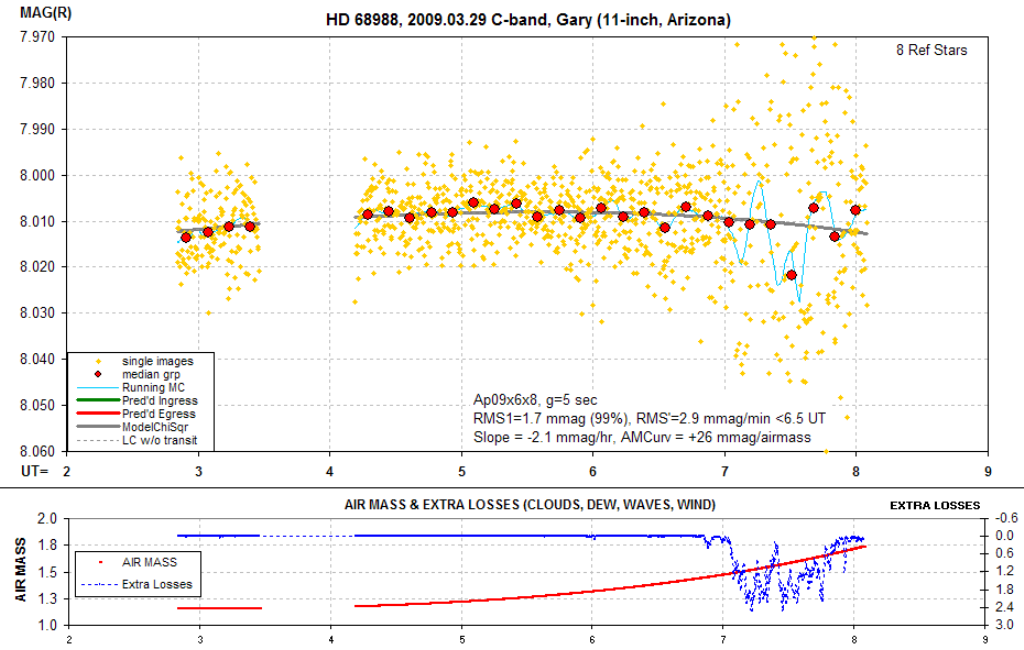
Bruce Gary (Arizona) observed in the normal "sharp focus" mode and found
no ingress or egress features during the 4-hour interval before clouds ruined
data quality.
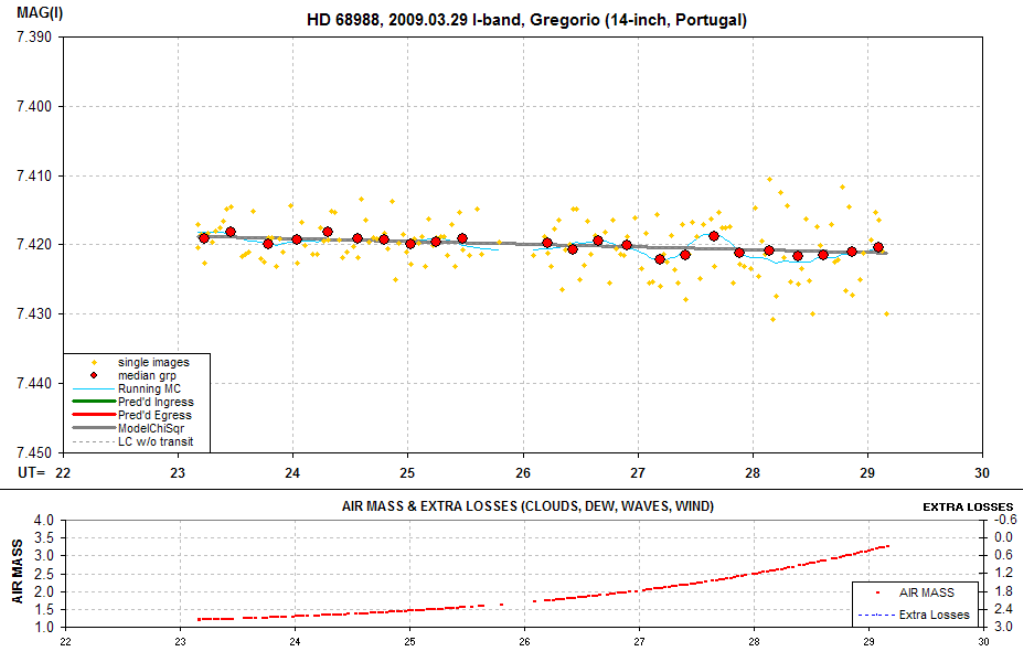
Joao Gregorio (Portugal) observed defocused under windy conditions for
6 hours and found no ingress or egress features.
OOT Observations
(Not 2009.03.29)
The following LCs are from dates other than 2009.03.29 - an observing
date that decisively "killed" the possibility of transits at the times suggested
by the "false alarm" LCs of 2009 February and March.
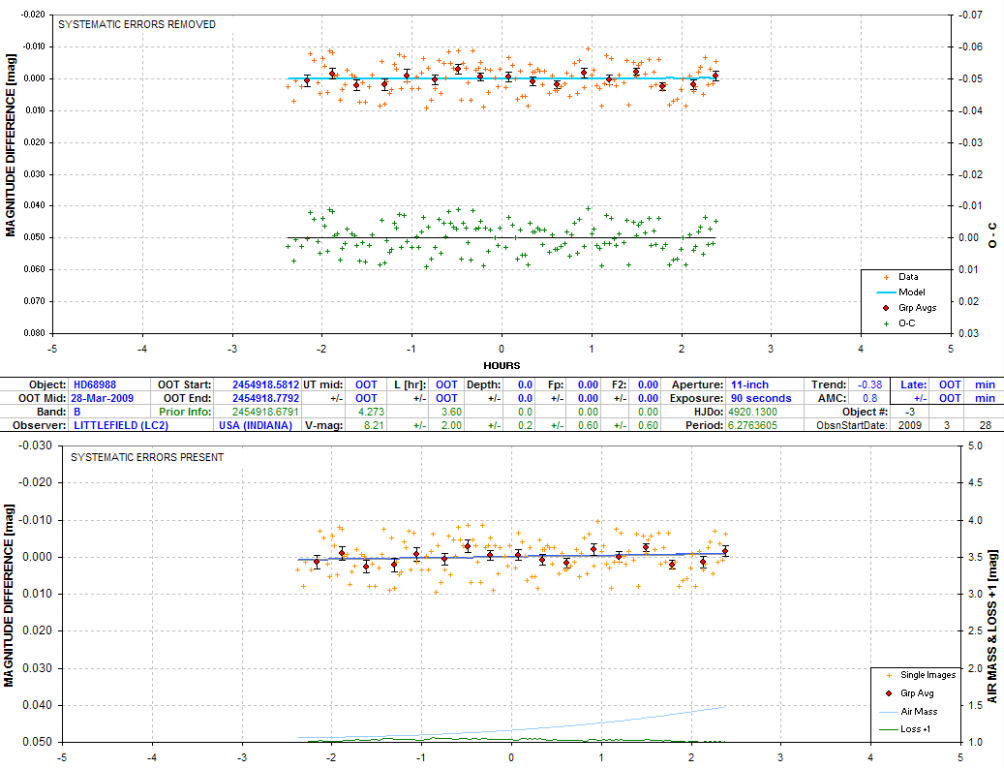
9328LC21

This OOT LC is by new observer Matej Mihelcic (Slovenia),
using a 2.5-inch "telescope." It shows that if the weather cooperates
there should be one more observer during the next transit event (March
29).
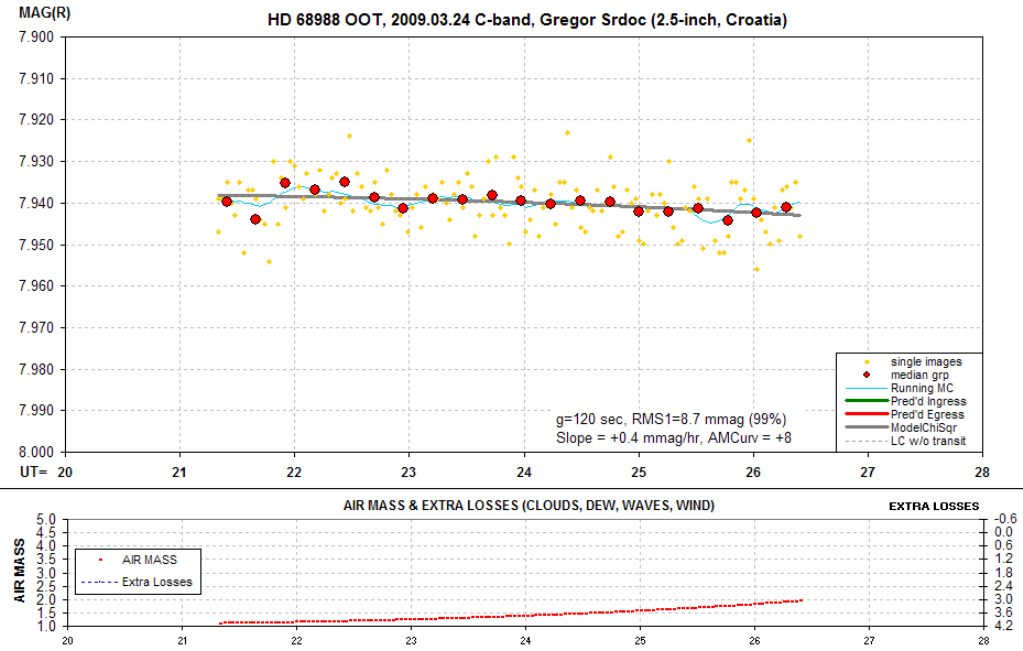
This is an OOT observation which serves to show how
Gregor Srdoc's 2.5-inch aperture system can perform when the weather is
good. Excellent!
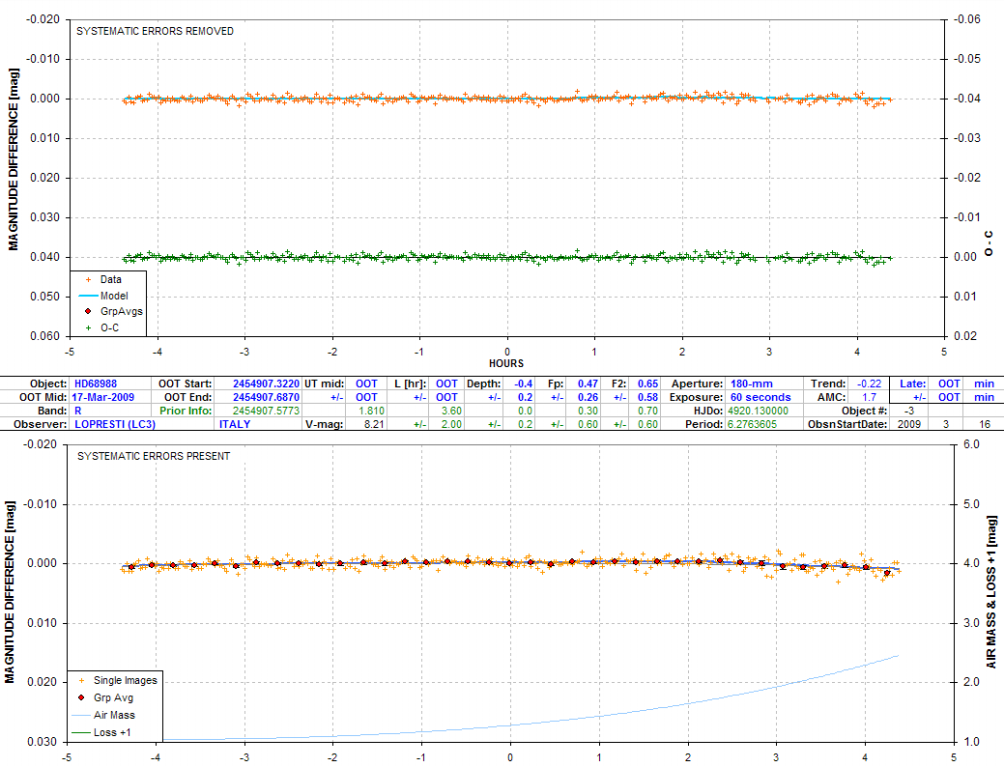
The best OOT LC that I've ever seen! Great work, Claudio Lopresti!

9316PCC1
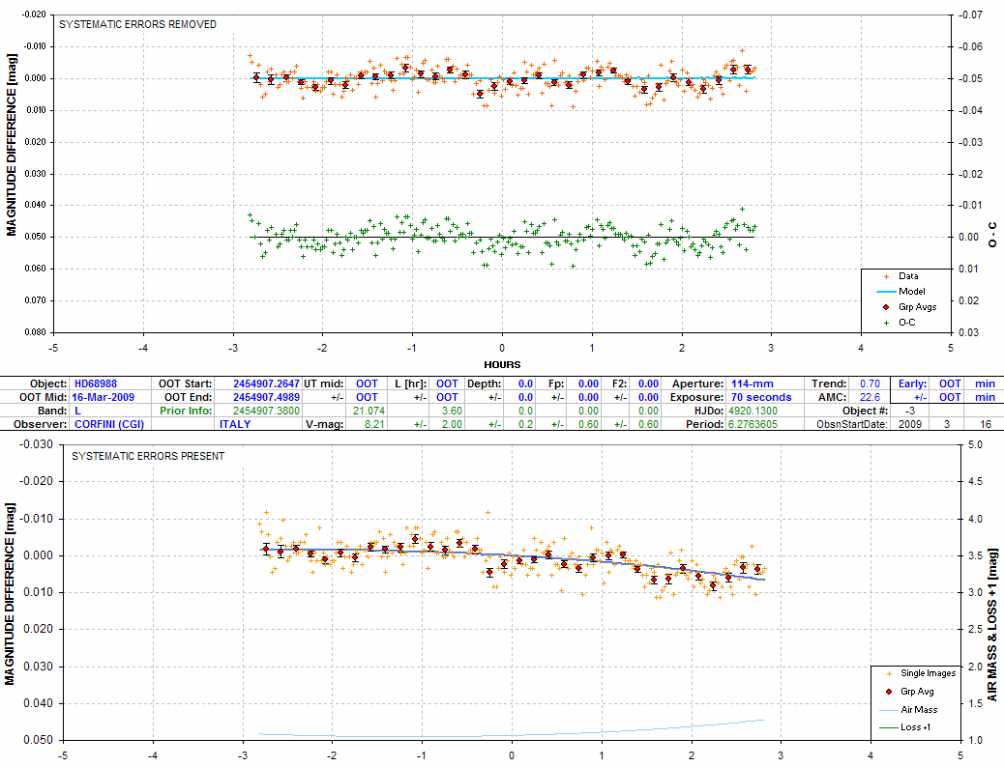
9316CGI1
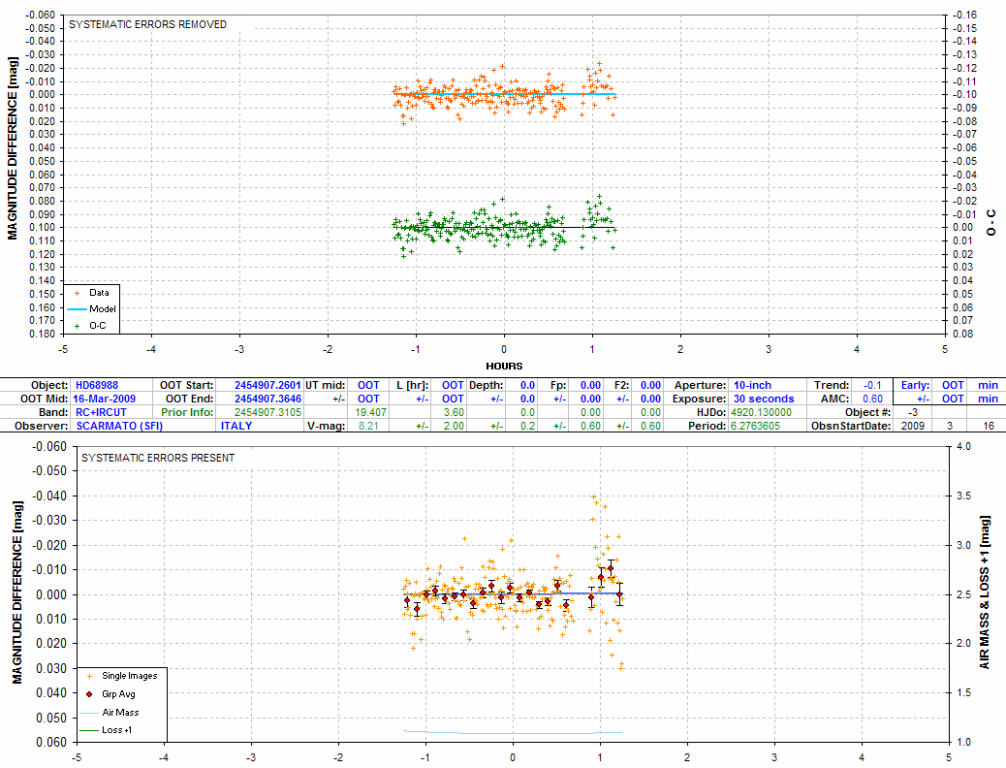
False Alarm Transits of 2009
February and March
There are 3 transit observations with positive detections (sort
of). They all agree on depth but are discrepant by several hours on inferred
mid-transit times (for events 4 periods apart). The two interpretation
extremes have led to my creation of two ephemerides (below). I cannot
produce an internally-consistent interpretation of the 3 LCs, and I take
the position that we cannot say that transits are occurring until we
have a transit with at least two observers producing consistent results
or until one model can explain all quality LCs. This object definitely
needs more observations!
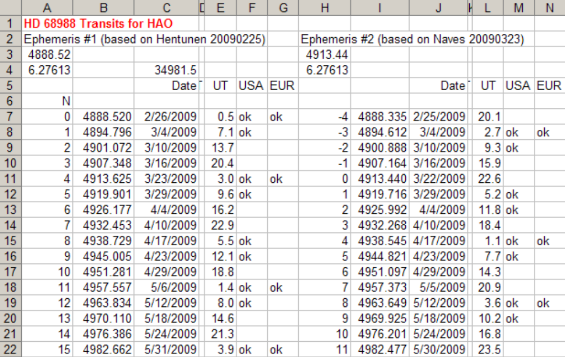
Two ephemerides
based on extreme interpretations of current LC data.

This is the situation for the next "event" for HD
68988, on March 29 UT. USA observers are in the best longitude for some
of the ingress and egress possibilities. Asian observers could evaluate
the RV possibility, but none have come forward yet. The whole HD 68988
situation is "muddled" so let's not get too excited by this object until
two LCs of the same event confirm each other in showing a transit feature!
Ramon Naves submitted
these data shortly after Srdoc, and a clear transit egress is apparent.
However, this egress occurs ~2.3 hours before the Srdoc egress, and there
is no ingress corresponding to the Srdoc ingress (at 25.9 UT). Observing
conditions were better in Spain than Croatia, and Naves used a larger
aperture that produced better precision, so this should be taken into account
as we try to reconcile these two LCs. Another consideration is the constraint
of the Hentunen egress time and a well-established period. The Srdoc/Naves
observations occurred 4 periods after the Hentunen observation, so we can
predict with confidence that for this event (March 22/23) egress should
have occurred at March 22, 28.8 UT. The Naves egress at 24.7 UT occurs
4.1 hours earlier. Also troubling is the requirement from the Naves LC that
transit length would have to exceed 4.0 hours, which is greater than the
3.6 hours derived from orbital parameters and star radius. It
is tempting to wonder if the Naves magnitude scale has a sign reversal,
but this is unlikely (and Ramon assures me that he checked this). I
conclude that we don't understand what going on! - and we NEED MORE
DATA! The next observing opportunity for Europeans is March 29, 04.4
UT (JD 4913.683).

9322NR21
Gregor Srdoc submitted
this data to AXA shortly after the predicted transit event (ingress/egress
= 25.2/28.8 UT, March 22, based on Hentunen's Feb 25 observation &
assumed 3.6 hr period).
Clouds unfortunately affected data quality starting ~ 1 hour before
ingress. Nevertheless, a chi-square solution was possible (that takes
data quality versus time into consideration), and the solution values and
statistical errors are given in the figure. The Hentunen data was only for
egress, so this is the first constraint we have on ingress timing, and
hence transit length, L. It appears that L < 3.6 hours, with a best L
~ 1 hour. Due to cloud effects on the data this result is very tentative.
It is reassuring, however, that the soution depth, D, is consistent with
the Hentunen result (9.0 ±
2.4 mmag versus 8.9 ±
0.4 mmag).
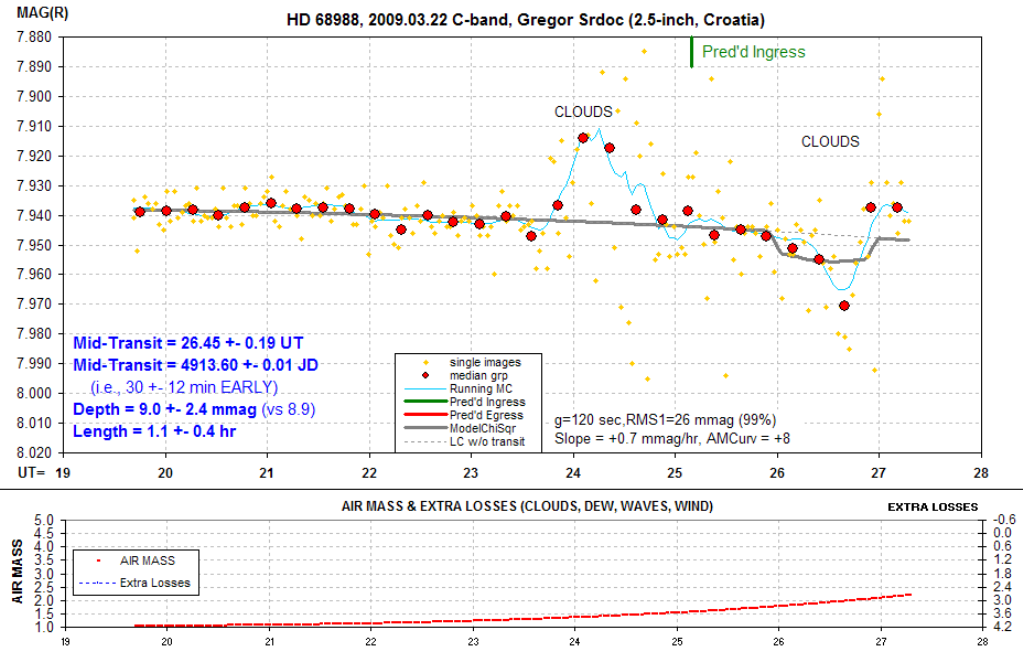
9322SG21
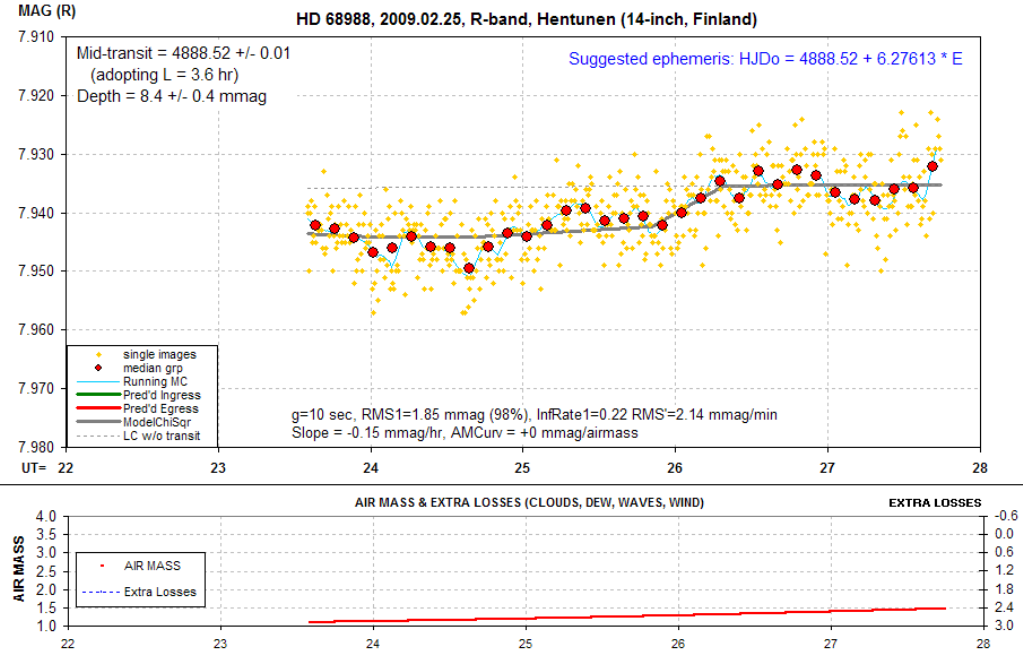
This could be a transit discovery! Good work,
Veli-Pekka Hentunen (Finland)!
Finder Image
Return to calling web page AXA
WebMaster: Bruce L. Gary. Nothing on this web page is copyrighted. This site opened:
2009.03.30. Last Update: 2009.04.03















